The Little Ghost Nebula is a planetary nebula located between 2,000 and 5,000 light years away in the equatorial constellation of Ophiuchus. The double-shell nebula has an apparent visual magnitude of 12 and an apparent size of 28 arcseconds. It is listed as NGC 6369 in the New General Catalogue.
The Little Ghost Nebula is composed of clouds of gas expelled by an evolved red giant star in the late stages of its life. When low- and intermediate-mass stars reach the end of their life cycles, they expel their outer layers into space. The expanding bubbles of ejected material form planetary nebulae, which are lit by the hot remnant cores of the progenitor stars. The ultraviolet light from the stellar remnants ionizes the nebulae, making them emit their own light.
The Little Ghost Nebula contains a bright inner shell surrounded by a larger filamentary shell. The annular inner shell has a barrel-like shape. It contains cometary knots and faint bipolar extensions.
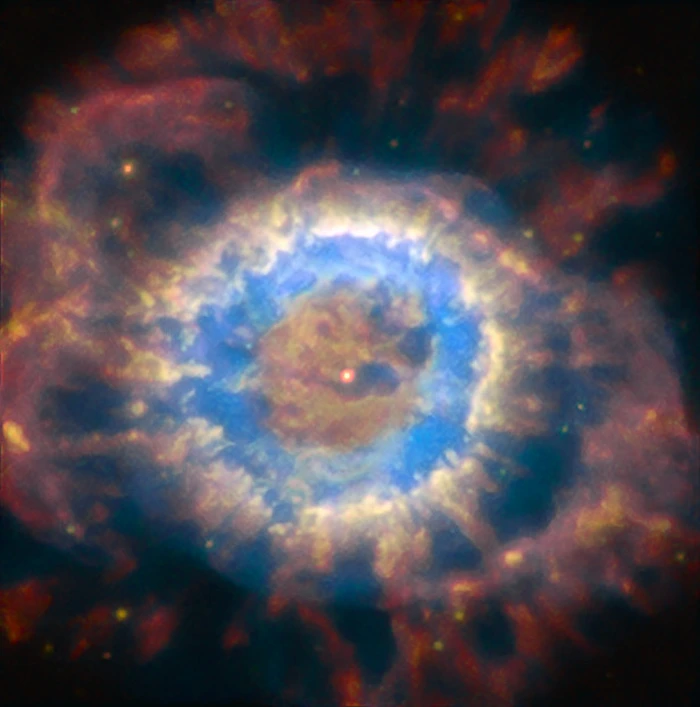
Known as the Little Ghost Nebula, NGC 6369 is a planetary nebula in the constellation Ophiuchus, the serpent-bearer. The nebula is relatively faint with an apparent magnitude of 12.9 and the clear detail of this image shows the power of the AOF-equipped MUSE instrument of the VLT. The white dwarf star is clearly visible in the middle of the nebular gas, which is expanding out in rings. Image credit: ESO/P. Weilbacher (AIP) (CC BY 4.0)
The main shell of the Little Ghost is about a light-year across in diameter. The ghostly cloud contains ionized hydrogen, oxygen, and nitrogen among other elements, and these appear green, blue and red in images.
The central star of the Little Ghost Nebula has an apparent magnitude of 15.6. It has the spectral class [WO3], which means that it has a spectrum similar to that of an oxygen-rich Wolf-Rayet star. However, unlike true Wolf-Rayet stars, a class that includes some of the most massive stars known, planetary nebula progenitors are Sun-like stars with masses up to 8 times that of the Sun.
In 2021, a team of astronomers led by N. Chornay, Institute of Astronomy, University of Cambridge, proposed that the central star of NGC 6369 may be a binary system (with a certainty of 78%), based on an analysis of the data obtained with the Gaia space observatory. Another 2021 study proposed the central star as a probable binary. Based on observations with the Kepler space telescope, the astronomers did not find the star to be variable.
Facts
The planetary nebula NGC 6369 was discovered by the German-born British astronomer William Herschel on May 21, 1784. Herschel observed the nebula with his 18.7-inch reflector and catalogued it as IV 11, with the description,” Pretty bright, round, pretty well defined planetary disk, 30 or 40″ diameter.”
Danish astronomer John Louis Emil Dreyer, who compiled the New General Catalogue in 1888, described the object as “very remarkable, an annular nebula, pretty bright, small round.”
The Little Ghost Nebula is one of the several well-known ghost-like nebulae in the sky. Others include the Ghost Nebula (Sh2-136) in the constellation Cepheus, the Ghost of Cassiopeia (IC 53) in Cassiopeia, and the Ghost Head Nebula (NGC 2080) near the Tarantula Nebula (30 Doradus) in the Large Magellanic Cloud in Dorado. Unlike the Little Ghost, these are larger emission and reflection nebulae. Some of them host newly formed stars.
The Little Ghost Nebula appears in the same area of the sky as several other deep sky objects. The Dark Horse Nebula, one of the most prominent dark nebulae in the sky, appears just to the north. The globular clusters NGC 6401 and NGC 6325 lie to the east and west, and NGC 6355 appears south of the nebula.
NGC 6369 was eclipsed by the Moon during the June 2011 total lunar eclipse.
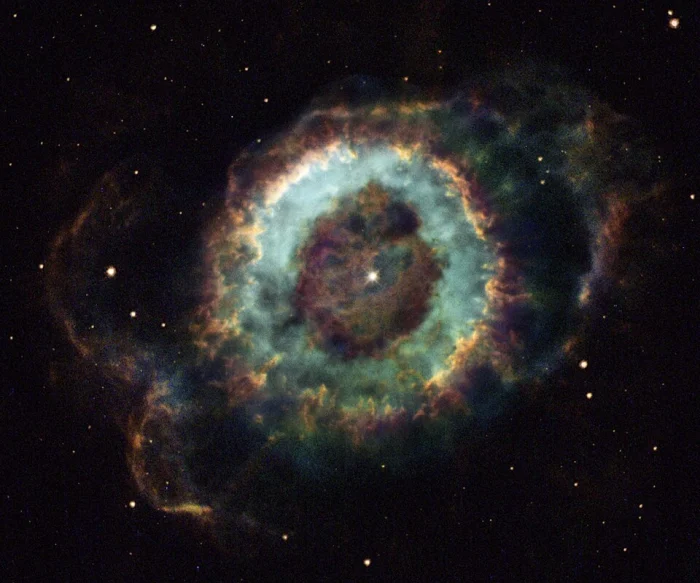
The NASA/ESA Hubble Space Telescope has caught a glimpse of a colorful cosmic ghost, the glowing remains of a dying star called NGC 6369. The glowing apparition is known to amateur astronomers as the ‘Little Ghost Nebula’, because it appears as a small, ghostly cloud surrounding the faint, central star. Credit:
NASA/ESA and The Hubble Heritage Team (STScI/AURA) (PD)
Location
The Little Ghost Nebula lies in the southern part of the constellation Ophiuchus, near the border with Scorpius. It appears a little more than halfway from Antares (Alpha Scorpii) in Scorpius to Polis (Mu Sagittarii) in Sagittarius, near the faint star 51 Ophiuchi.
NGC 6369 lies 23° 45’ south of the celestial equator and is visible from most places on Earth for at least part of the year. Like all planetary nebulae, it is best seen in larger telescopes at high magnification.
The best time to observe the Little Ghost Nebula and other deep sky objects in Ophiuchus is during the month of July, when the constellation appears higher above the horizon in the early evening.
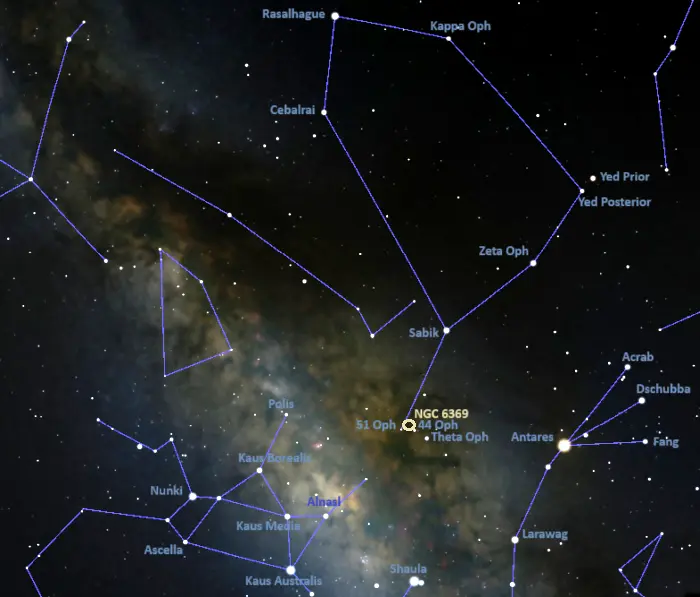
Location of the Little Ghost Nebula (NGC 6369), image: Stellarium
Little Ghost Nebula – NGC 6369
| Constellation | Ophiuchus |
| Object type | Planetary nebula |
| Right ascension | 17h 29m 20.4566510904s |
| Declination | −23° 45′ 34.771819248″ |
| Apparent magnitude (V) | 12.0 |
| Apparent magnitude (B) | 16.6 |
| Apparent magnitude (J) | 12.452 |
| Apparent magnitude (H) | 11.873 |
| Apparent magnitude (K) | 11.475 |
| Apparent size | 28″ |
| Distance | 2,000 – 5,000 light-years (613 – 1,533 parsecs) |
| Radius | 0.136 – 0.34 light-years |
| Names and designations | Little Ghost Nebula, Ghost of Mars Nebula, NGC 6369, ESO 520-3, PK 002+05 1, Henize 2-232, Hen 2-232, PN VV 101, My 101, PN VV’ 199, PN ARO 51, PN G002.4+05.8, PN Sa 2-207, WRAY 16-277, IRAS 17262-2343, 2MASS J17292045-2345347, AM 1726-234, EPIC 224716713, HD 158269, V* V2310 Oph, CD-23 13397, GCRV 10105, WEB 14444, SCM 146, TIC 165348020, GSC2 S222112038629, OHIO T -244, Gaia DR2 4111368477921050368, Gaia DR3 4111368477921050368 |
Images
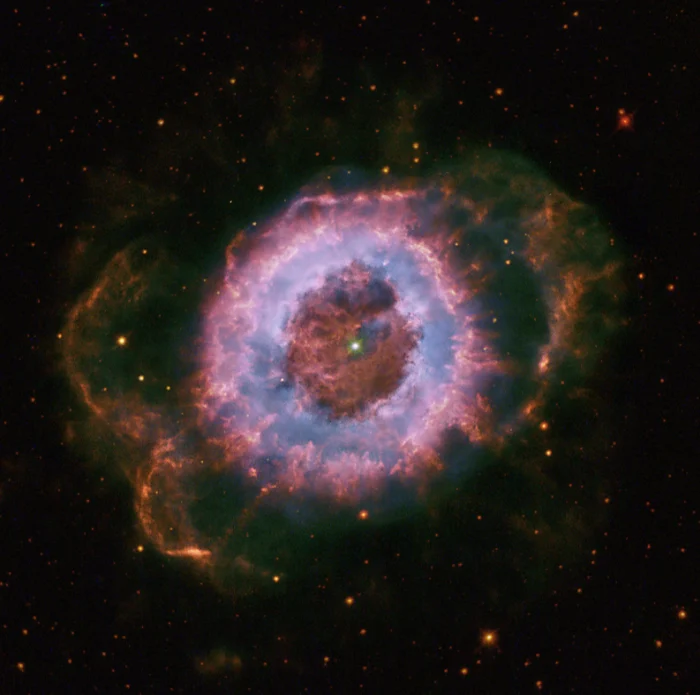
The Little Ghost Nebula (NGC 6369), image credit: Judy Schmidt (CC BY 2.0)
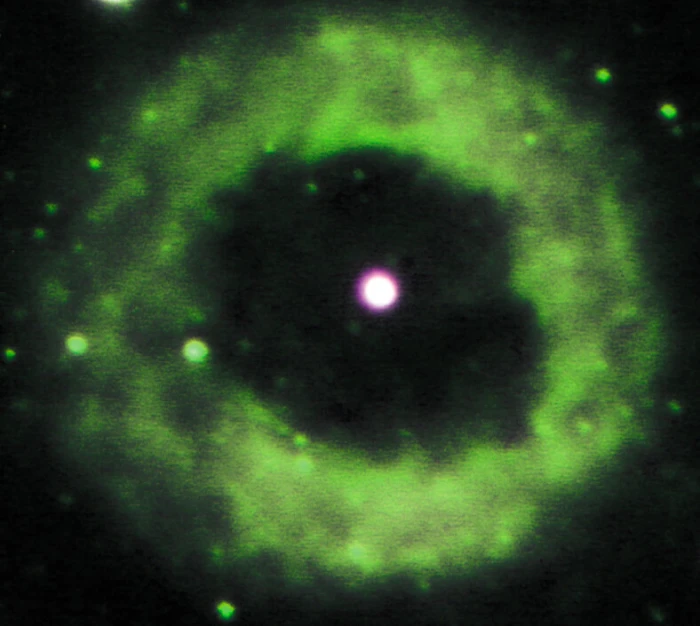
Little Ghost Nebula captured by Gemini South telescope, credit: NOIRLab (CC BY 4.0)
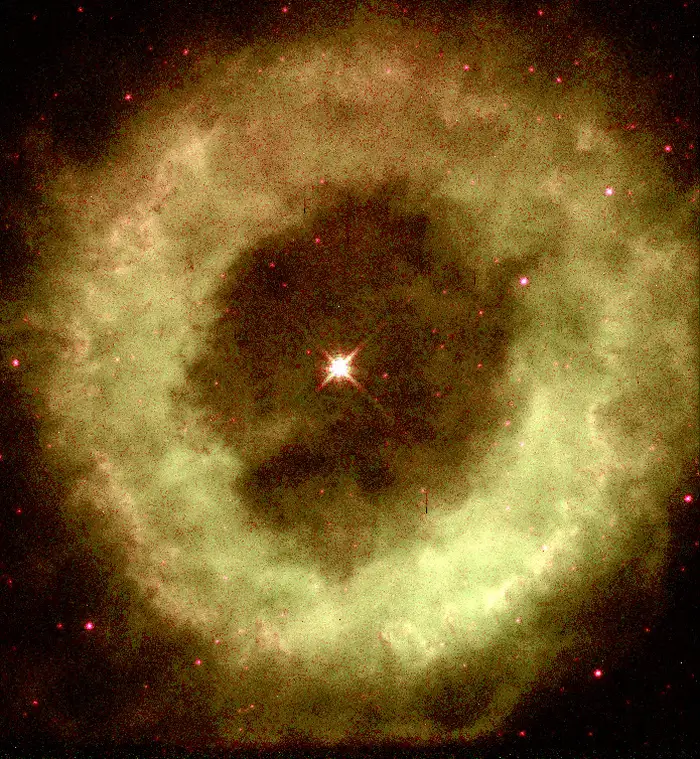
A Hubble image of the Little Ghost, credit: NASA/ESA and H. Bond (STScI) (PD)